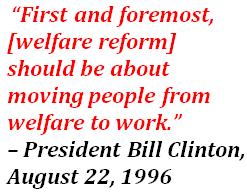Are government-provided welfare benefits in the U.S. too generous?
The correct answer is “it depends”. Specifically, it depends on whether or not an individual who is able to take advantage of other options available to them to sustain their existence, such as earning income by working in a job, would reject those alternatives in favor of taking welfare benefits from the government.
That choice is a rational one if the value of the benefits that they can obtain on welfare is greater than the income they could earn by working in a job.
And that’s the case for all low-income jobs in 34 states and the District of Columbia, which are shown in blue in the map we created below based on the findings of a new study by Michael Tanner and Charles Hughes.

Tanner described his research in an article at National Review:
The federal government currently funds 126 separate anti-poverty programs at an annual cost of $688 billion. Of these, 72 provide cash or other benefits directly to poor families. State, county, and municipal governments often operate additional benefit programs. The combined benefits from those multiple overlapping programs can easily add up to the point where welfare simply pays better than work.
This week, the Cato Institute released a new study calculating the state-by-state value of this typical welfare package for a mother with two children participating in seven common welfare programs — Temporary Assistance for Needy Families (TANF), food stamps (SNAP), Medicaid, housing assistance, WIC, energy assistance (LIHEAP), and free commodities. We found that, in 2013, the value of those benefits varied widely across states, from a low of $16,984 in Mississippi to an astonishing high of $49,175 in Hawaii.
[…]
We found that, just to break even, a person on welfare would often have to take a job that paid considerably more than the value of the forgone welfare benefits. In Hawaii, for example, a person leaving welfare for work would have to earn more than $60,590 a year to be better off. In fact, welfare currently pays more than a minimum-wage job in 34 states and the District of Columbia. In Hawaii, Massachusetts, Connecticut, New York, New Jersey, Rhode Island, Vermont, and Washington, D.C., welfare pays more than a $20-an-hour job, and in five additional states it yields more than a $15-per-hour job.
Political Calculations has an interactive map that visualizes the equivalent pre-tax income that these typical welfare benefits provide by state (both annually and hourly), along with each state’s median income (again both annually and hourly), and also the prevailing minimum wage in each state and the percent that the hourly “welfare” income is with respect to each state’s minimum wage.
So the answer to the question “are government-provided welfare benefits in the U.S. too generous?” is still “it depends” – only now, it would also appear to greatly depend upon which state is issuing the benefits.
 |
Featured Image:
Congressman Jack Kingston |